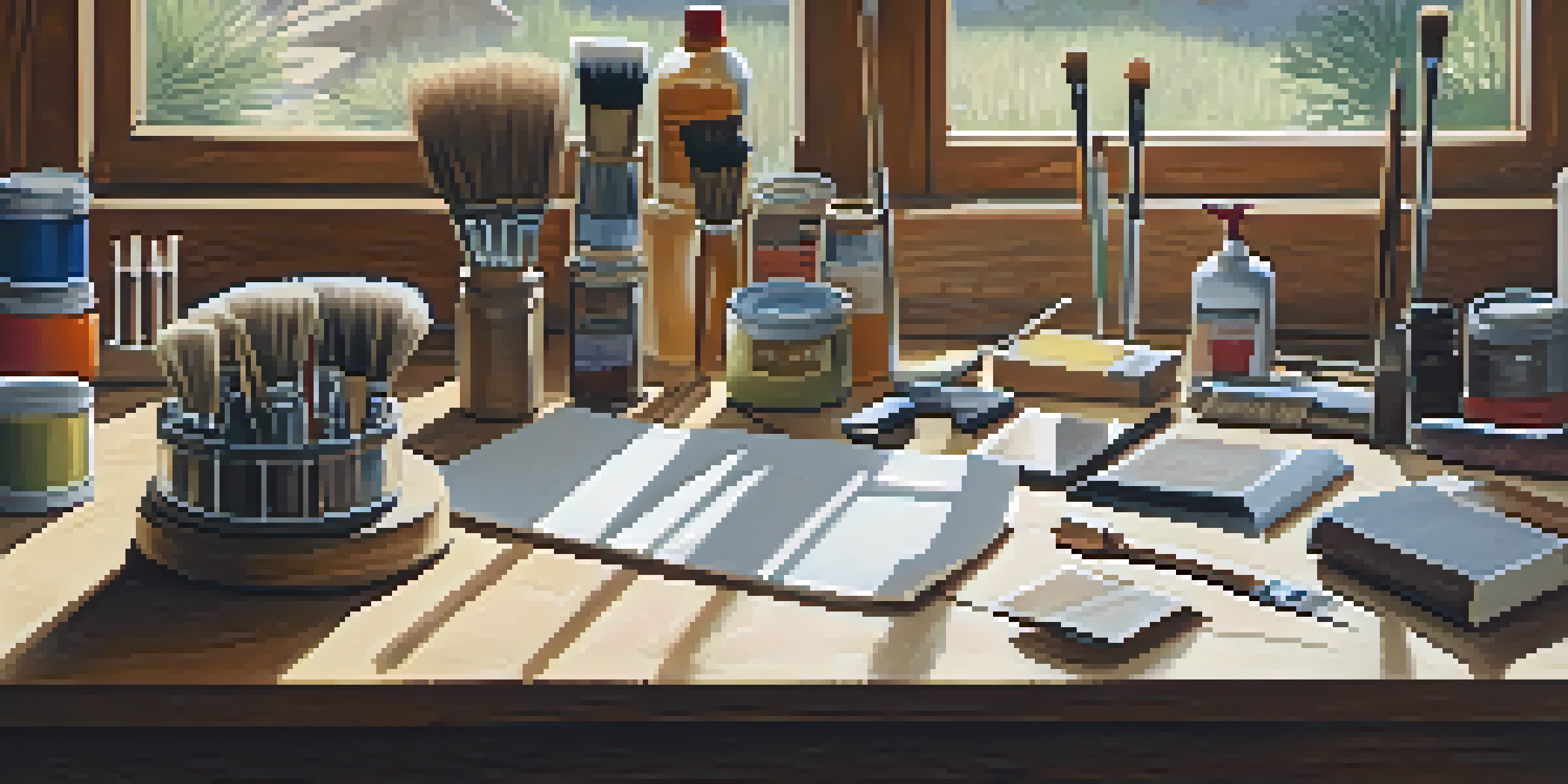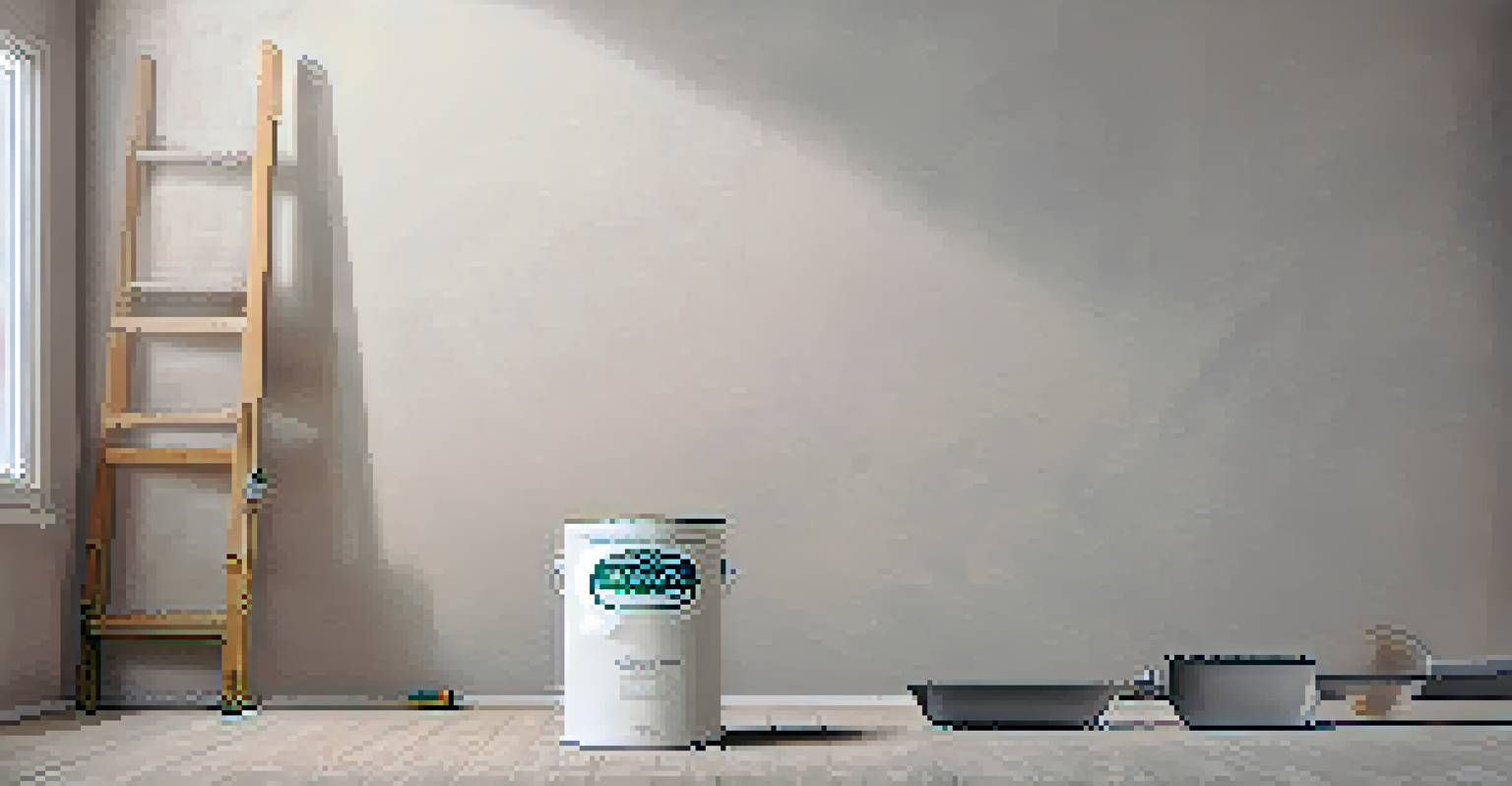Surface Preparation: The Key to Successful Paint Application

Understanding Surface Preparation and Its Importance
Surface preparation is the process of getting a surface ready for painting. This can involve cleaning, sanding, and priming to ensure the paint adheres properly. Think of it like preparing a canvas before painting—without a smooth, clean surface, your artwork won't shine.
Preparation is the key to success.
When surfaces are not properly prepared, issues like peeling, bubbling, or uneven finishes can occur. This not only affects the aesthetics but can also lead to costly repainting jobs down the line. Taking the time to prepare surfaces can save both time and money in the long run.
In essence, proper preparation is the foundation of a successful paint job. Just as a sturdy foundation is critical for a building, a well-prepared surface is essential for paint application. Skipping this step is like baking without measuring ingredients—you might get lucky, but you’re more likely to end up with a mess.
Common Surface Issues That Require Attention
Before you start painting, it's important to identify any surface issues that need addressing. Common problems include dirt, grease, rust, and old paint that’s peeling or cracking. Each of these can hinder the paint's ability to adhere, leading to subpar results.

For example, if you were to paint over a greasy surface, the paint would struggle to stick, causing it to peel away shortly after application. Similarly, rust on metal surfaces can spread under the paint, leading to even more issues later. Identifying these problems upfront allows you to tackle them effectively.
Importance of Surface Preparation
Proper surface preparation is crucial for ensuring paint adheres well, preventing costly issues like peeling and bubbling.
Addressing these surface issues is like cleaning your house before guests arrive—it's essential for making a good impression. By taking care of these details, you're setting yourself up for success, ensuring that your paint job looks great and lasts longer.
The Essential Tools for Surface Preparation
Having the right tools can make all the difference in surface preparation. Common tools include sandpaper, scrapers, brushes, and cleaning solutions. Each tool serves a specific purpose, whether it’s smoothing rough edges or cleaning grime.
The best way to predict the future is to create it.
For instance, sandpaper is essential for removing old paint and rough spots, while scrapers can help lift peeling areas. Using the right cleaning solution can ensure that the surface is free of contaminants that might interfere with adhesion. Think of these tools as your paint prep toolkit, essential for achieving that flawless finish.
Investing in quality tools not only makes the job easier but also improves the end result. Just like a chef wouldn’t use dull knives to prepare a meal, a painter shouldn’t skimp on tools when prepping surfaces. Quality preparation tools lead to quality results.
Step-by-Step Guide to Preparing Surfaces
Preparing a surface for painting involves several key steps. Start by cleaning the surface thoroughly to remove dirt, grease, and dust. Next, inspect for any imperfections such as cracks or peeling paint that need addressing before moving forward.
Once the surface is clean, use sandpaper or a scraper to smooth out rough areas and remove any old paint. After sanding, wipe the surface with a damp cloth to eliminate any dust particles that may have been created during this process. This step is crucial for ensuring a smooth finish.
Common Surface Issues to Fix
Identifying and addressing problems such as dirt, grease, and rust before painting is essential for a successful finish.
Finally, applying a primer can help seal the surface and enhance paint adhesion. Just like a solid base is essential for a cake, a good primer is critical for a beautiful paint job. Following these steps ensures your surface is well-prepared and ready for a stunning finish.
The Role of Primers in Surface Preparation
Primers play a vital role in surface preparation, acting as a bonding agent between the surface and the paint. They help seal porous surfaces, preventing the paint from soaking in and losing its vibrancy. Think of primer as the first layer of protection for your wall—it's essential for a long-lasting finish.
Using a primer can also improve the durability of the paint, making it resistant to stains and scratches. Without it, your paint job may not only look less polished but could also deteriorate much faster. This is especially important in high-traffic areas or outdoor applications where the paint is exposed to the elements.
Choosing the right primer for your project is crucial. Different surfaces may require different types of primers, such as oil-based or water-based, to ensure optimal adhesion and performance. By investing in quality primer, you're ensuring that your paint job stands the test of time.
How Weather Affects Surface Preparation
Weather conditions can significantly impact the effectiveness of surface preparation and paint application. Ideal conditions typically include dry, moderate temperatures with low humidity. Painting in extreme weather—be it too hot, cold, or humid—can lead to problems like poor adhesion or rapid drying.
For instance, if it's too humid, moisture can get trapped under the paint, leading to bubbling and peeling. On the other hand, painting in extremely hot conditions can cause the paint to dry too quickly, preventing proper adhesion. Understanding the weather will help you choose the best times to tackle your painting projects.
Using Quality Tools and Primers
Investing in the right tools and quality primers enhances the effectiveness of surface preparation and leads to durable paint results.
Monitoring the forecast before starting your project is like checking the tides before sailing—essential for a smooth journey. By planning around the weather, you can ensure that your surface preparation and paint application go off without a hitch.
Final Tips for Effective Surface Preparation
As you gear up for your painting project, remember that thorough surface preparation is non-negotiable. Take your time during this step; rushing can lead to mistakes that may affect the overall outcome. A little extra effort now can save you from headaches later.
Don’t forget to read the manufacturer’s instructions on the paint and primer you choose. These guidelines often provide valuable insights into optimal application conditions and techniques. Following these recommendations ensures that you get the best performance from your materials.

Lastly, always wear appropriate safety gear when preparing surfaces, especially when sanding or using chemicals. Protecting yourself while you work is just as important as the quality of your finish. With these tips in mind, you’re well on your way to achieving a stunning and long-lasting paint job.